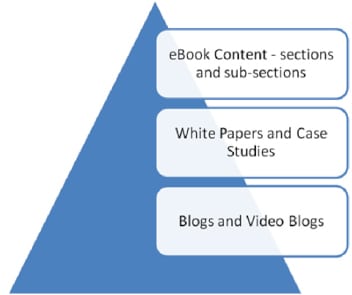 |
| Think of your route to an eBook as a pyramid, with content layered on top of each other—all of it to be repurposed and promoted on a variety of platforms—culminating at the top as a finished book. |
There is something about being a published author that raises credibility with the news media. Perhaps because so many reporters, editors, producers and hosts have either written books (or wish they could have), an individual with a topical book credit seems inherently more newsworthy, as well as more credible.
Today’s social networks have created an easy and ideal platform for both creating and “pre-selling” a topical non-fiction book, making it far easier for a supportive PR exec to turn a client or member of the C-suite into a respected and credible author.
Following a pyramid approach (see the graphic)—building content on top of content—this can be accomplished in few easy steps.
1. Plan the book. Come up with a topic and a title for the book, defining the information to share and the market to reach. Then create a table of contents for the book that is at least seven to nine chapters long. The first chapter will tell the readers what the book is going to cover. The middle chapters will present the real and in-depth content. Finally, the final chapter serves as a summary.
2. Map out the book. Break down each of the middle chapters into a detailed series of sections and sub-sections, an approach that is standard for business-oriented, non-fiction books. Having done that, the book is ready to be researched and written.
3. Do research and reporting. Sit for a series of brief interviews with the book’s author, then review and edit what you write—the notes, the blogs, the case studies, the white papers and finally, sections of the book. Write the material yourself or engage a ghost-writer, so the “author” doesn’t get bogged down in the process.
4. Take that interview material and write it in several different formats. Utilize blogs, vlogs, white papers and case studies before finally rewriting as a sub-section for the book. Create at least three blogs for every white paper or case study, and two to three white papers or case studies for each book section. Blogs should be relatively short and to the point —they should cover a single, focused topic—while white papers and case studies can cover several topics in a single document.
5. Socially promote. For each posted content item, flag it something like this: “Written by John Client, author of the forthcoming book, John’s Book, and based on material which has been developed for that book.” Then create seven tweets, five Facebook posts, three Linkedin posts—as well as on other social networking platforms—along with a single press release, all to help attract people to your published material.
Keep re-using the same material, in different formats that suit different audiences, each time gaining additional followers and further enhancing your client’s market-niche reputation.
Using this approach, you build the content of an eBook via the creation of useful social networking content posts, appropriately promoted using online and traditional PR tools. Your client or executive will become known as an author long before the book is completed, and an eager audience will have been primed and prepped for when that book is finally released.
CONTACT:
This article is written by Ned Barnett, president of Barnett Marketing Communications, and the author of 10 books. He can be reached at [email protected].
